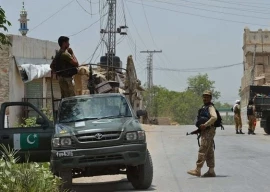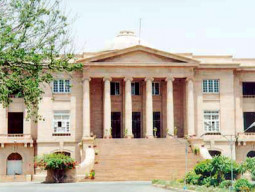
Not many people know that a number of Karachi’s landmark buildings were designed by a Jewish architect Moses Somake (1875-1947). While he was born in Lahore, he lived most of his life in Karachi before migrating to England a few months before the Partition of India.
Reading a paper at Karachi conference here on Saturday, Gul Hasan Kalmatti, traced the history of Karachi’s Jewish community and recalled their contribution in making Karachi a vibrant metropolis.
“It’s funny how [the other speakers] have mentioned Kalhoros and Jatois,” said Kalmatti, referring to tribes who still exist today. “But today I am speaking of the Yahudis [Jews]. The Kalmattis are still here but the Jews are not.”

He revealed that historic buildings like Mules Mansion in Keamari, BVS Parsi High School and the Karachi Goan Association Hall in Saddar, Khaliqdina Hall on Bunder Road, Jaffer Faddoo Dispensary in Kharadar, Edward House on Victoria road and the famous Flagstaff House were all designed by Moses Somake. “They were our stones, our buildings,” he said. They are no longer there. The design and architecture of some famous hotels of yore - North-Western Hotel, Bristol Hotel and Carlton Hotel - was also conceived by this architect of Iraqi origin.
Tracing the history of Karachi’s lost Jewish community, Kalmatti said they belonged to the Bene Israel diaspora who had settled in the early 19th century coastal towns of India, including Karachi. Most of these people had settled in quarters along Lawrence Road, Ramswami Quarters and Ranchore Lane.
You will still find nine streets from Jubilee market with the names from our Hindu, Jewish and Muslim heritage: Solomon David street, Seth Harchand street after the mayor of 18 years, one named after Yousaf Ali Alibhai who organised cricket.

Kalmatti regretted that the synagogue known as the Magen Shalom Synagogue was razed to the ground in July 1988, paving the way for a shopping plaza - Madiha Square. The synagogue was built by Solomon David Omerdekar in 1893. In 1895, a community hall was added to this synagogue in memory of Solomon’s wife, Shegulbai. His sons established a Hebrew school in the synagogue’s premises in 1918 and constructed a Nathan Abraham Hall. Solomon, who was the chief of the city’s Jewish community and a surveyor of the Karachi Municipality, lies buried along with his wife in Karachi.
According to Kalmatti, a leading member of city’s Jewish community, Abraham Reuben, was elected to the Karachi Municipal Corporation thrice - in 1919, 1936 and 1939. He established a school in 1927 that still exists in Liaquatabad’s Haji Mureed Goth and is named after him.
Giving the estimates about the growth of Jewish population in Karachi, Kalmatti said that according to the 1881 census, there were only 153 Jews in Karachi and the number at the time of Partition of India stood at 2,500. But most of them migrated to Israel after it came into being in 1948. However, by 1968 there were only 250 Jews living in Karachi. After their synagogue was destroyed, the remaining few Jews, fearing for their lives, started identifying themselves as Parsis and Christians.
At the end of his presentation Kalmatti sounded quiet poignant, recalling that Karachi was a tolerant, peaceful city when inhabited by people from diverse religious backgrounds. “We are 99% Muslims now but we’re cutting each other’s throats,” he said. Today when there are no Jews, fewer Hindus and only a few Goans and Parsis and the overwhelming majority subscribe to the same religion, they are after each other’s blood.
Published in The Express Tribune, November 3rd, 2013.
COMMENTS (30)
Comments are moderated and generally will be posted if they are on-topic and not abusive.
For more information, please see our Comments FAQ

1731329418-0/BeFunky-collage-(39)1731329418-0-165x106.webp)



1731771315-0/images-(3)1731771315-0-270x192.webp)











No doubt, Karachi was a most tolerant place city. It was converted into a bastion of intolerance and extremism by snatching it,s beautiful historical Sufi-Sindhi identity. Its most civilized people Sindhi-Hindus were forced to leave with the merciless and inhumane forces... Though, it all was against the vision of the founding father of this country but... alas! due to his ill health the forces of extremism and intolerance managed to convert Karachi into a highly intolerant place. Just a single example( though there are thousand examples) : the name of "Raam Baagh ( Raam Garden)" was converted into "Arram Baagh".... This was not an isolated act but result of a very cruel process of intolerance. And, of course, demolition of Mandirs / synogoge was result of the said cruel process. The blindness is still haunting without fail, under the guise of various misconceptions and historical distortions.... the noise/ frustration- "Karachi had nothing to do with Sindh..Karachi was british colony" etc is nothing but poverty of philosophy... last but not least...Sindhis must not get angry on such historical distortions because, no one erase the collective memory of humans. And, should contribute towards a tolerant and progessive Pakistan.
Comments by most of radical Muslims are so sweeping here. No matter what but Jews are still in Pakistan under fear and pain. They must be accepted as honorable citizens of Pakistan. The radicals are Satanists and they only like to cut the throats of human beings.
@ET Moderator,
Just a small note:
Good article and I am glad someone is emphasizing the extremely positive role that the minorities played pre-partition in building Karachi. That said, the last sentence of "@ Sindhi_Pakistan" is extremely offensive. That line should have been edited out if the comment was to be published at all. There should be zero tolerance policy for such blatant ethnic-bashing or racist comments like "The mindset of Sindhi people..." Disgusting. That sometimes such comments are made by agenda-driven trolls is one more reason not to include hateful comments, or at least to edit out the obnoxious part.
@farooq naqvi: They are still called the same.
Before partition Muslims living in Karachi WERE not allowed to go any recreation places LIKE Clifton on any holidays specialy Saturday and Sunday only Hindu and. Christians WERE allowed to go there Muslims were living in liyari and called dunki cart wala.
@M K Sufisufi.: Sir I am 26 and can only relay what I heard from my mother. In actuality before all the problems started in Karachi after miles away in 1948 when Arab Israel conflict started, before that I am told there was no division among people of all race, religion and social standing. Back then it was not a surprise when a non Moslem wrote Pakistans first anthem (or was it national song). I mostly use twitter we can talk over there more. Twitter= @Jew_Pakistani
@Nouman: Great comment. Thanks.
@@Jew_Pakistani: We would like to know the Karachi of your time.
@cut: Sir there were Baghdadi Jews also who migrated from Iran to Karachi during British rule and stayed in Pakistan because ex-homeland was nearby.
Twitter= @Jew_Pakistani
@Nouman: Sir we can communicate via my twitter @Jew_Pakistani
@AG Babar: I am so sorry for your pain...but with apartheid being faced by non-sindhi speaking Sindh domicile holders.....all the jobs and seats have been marked for your clan and that is the root of all evil............certainly all Sindhis are not Zardaris but it is very difficult indeed to spot an honest and non-rishwat-khor Sindhi.....resources of Sindh are not be usurped by Sindhi speaking Waderas alone and the riches will have to shared equally otherwise there will always be stink. The problem is the rural and primitive mentality which says that one has to be part of the clan to share the spoils.
@Jew_Pakistani: I understand you wish to stay anonymous but please do share your experiences, history and current state. We would love to see original snaps of jewish life in Karachi. Gosh, I am so shocked.....but I was taught in history that only arabic speaking, horse riding Muslim explorers roomed in Karachi in that past.
Trace the origin of Mr. Zardari, he is Baloch - Just correction. And please don't divide. Be Pakistani!
@AG Babar:
Zardari is not sindhi he is baloch.
It is ironic that Pakistanis care so much about the Babri masjid in India that was destroyed, but feel nothing about destroying the jewish synagogue, temples or churches in Pakistan.
@ Sindhi_ Pakistani please tell me about ur academic record & to all those intellectuals who has given 26 likes to this stupid comment based on an individuals linguistic difference, please do not encourage such thoughts prevailing in our society.. P.S Zardari is a sindhi but all sindhis are not Zardari
My Jewish mom lived at Alwar Mansion,Nisther Road,Orange Street,Lawrence Road, near Ramswami. I still have pictures of her in her pre partition home in Karachi Pakistan.
Twitter= @Jew_Pakistani
No single community ever builds a city alone. Karachi owes a lot to the contribution of Parsis, the Hindus and the Christians too. Do not write captions based on emotional tones.
The religious zealots have no regards for any one .. the shias were the one who founded this country only to find their next generations slaughtered by their own country men. Every sec , race who thinks these morons have any regard for any one is seriously mistaken. Jab tumhari bari aey gi than you will remember it. The shias remained quiet when the ahmedis were discriminated and persecuted by their own state
@@ Sindhi_ Pakistani: You are so right. I am pleased that as a Sindhi you have identified the problems of interior Sindh. Regrettably its the MQM's onslaught on Karachi that has destroyed the vitality and the melting pot of cultures. We know what Paradise Lost now means.
Karachi never was had any mention in any Sindhi gospels or their invented history. It was slightly more then a fishing village dotted on the coast from Gwadar to Mumbai and further along. It wasn't until British established a light house here and made this their cantonment ( Old Saddar Area) , followed by Parsis who probably wanted Karachi to turn into their business district. Smaller trader ( hindus) and Bohris and Probably Jew ( from Maharashtur) followed. But jews here were mostly skilled trademan like musicians, pianists, jazz players etc.
Then fast forward and because of major rule of Sir Aga Khan and Jinnah in Muslim league and Karachi being their home town , Karachi was made the federal entity and capital of Pakistan.
And thats why, Mujahirs from UP ( India ) came and settled in Karachi because they wanted to live in the heart of Pakistan. Until then ,it was Hyderabad which was the capital of Sindh , Deebal /Thatta was the fading sea port and savage Waderas had not infested Karachi with their guns and cave man mentality.
@ Amir: Babri masjid was destroyed by a 20,000 strong hindu mob. This unused synagogue was legally demolished for a shopping mall by a private company. BIG DIFFERENCE.
And its Idiotic to think that Jews built Karachi, because a Jew designed some old buildings in pre-partition Karachi. Jews were a very tiny minority in Karachi even before Partition. Karachi was a very small hindu and muslim fishing village before partition.
When I was a child, years ago, our neighbour was a Jewish family ( the Benjamins ). We all went to school together and played together. All I remember is that they were gentle, loving and generous people.
The last para is worth commenting ...... Y think aloud abt the current state of affairs . .,. Hate begets hate ...... Mass murders on religious grounds will have some effect ..... It's called mass bad dua . . . . . So no .... Peace only for the non violent for religious zealots ... It's death by their own kin
We cried fowl when Babri masjid was riazed to the ground by Hindu fundamentalists.
Where were these voices when we Muslim razed a synagogue down to build a parking lot?
All religion and communities have played a very important part in building the subcontinent, and we must not forget them.
Karachi has nothing to do with sindh or Sindhi ... Karachi was the british colony and Sindh never ruled in this city... Further Sindh culture is finely projecting in interior Sindh... with every where garbage , open holes , sewerage water and broken schools.... The mindset of Sindhi people start from corruption and ends at corruption.
There are few landmarks of great Sindhis such as Hakim Ali Zardari road, Bilawal House, Qaim Ali Shah street etc. Just kidding :-)
Karachi is heartland of Sindh. Sufi Sindhi culture and language should be projected in Karachi. Please name streets, buildings and institutions behind the names of great sons of Sindh.
Karachi.............Get ready for the change of all 'yahoodi' names of streets and schools mentioned above...........and wiping out of all 'yahoodi' graves left in karachi......... Such is our tolerance and morality that we are not able to accept anything less than our own views..............not even islam as practiced by other thoughts.
A small correction "Bene Israelis" settled around 1500 yrs in Maharashtra's coastal areas.They speak Marathi language.